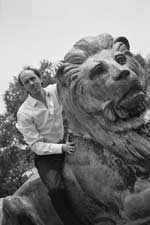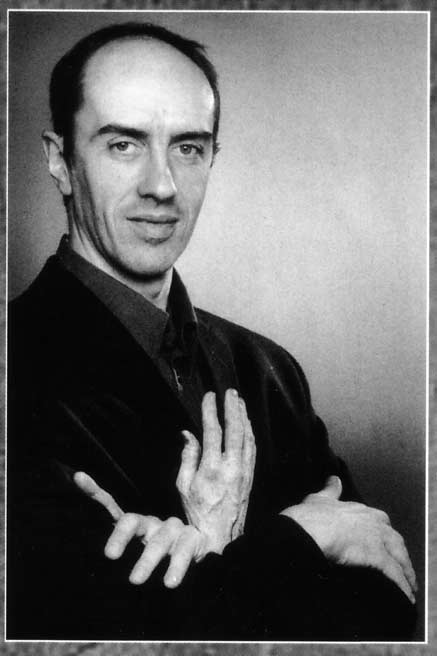Hervé Niquet and la Nouvele Sinfonie by Réjean Beaucage
/ September 3, 2003
Version française...
 Montrealers are in for a treat when La Nouvele
Sinfonie presents Les ballets de Jean-Féry Rebel under the baton of
conductor-founder Hervé Niquet, Saturday, September 13, at 8 pm in Montreal's
Salle Pierre-Mercure, Centre Pierre-Péladeau (300, de Maisonneuve East, info:
514-987-6919). Montrealers are in for a treat when La Nouvele
Sinfonie presents Les ballets de Jean-Féry Rebel under the baton of
conductor-founder Hervé Niquet, Saturday, September 13, at 8 pm in Montreal's
Salle Pierre-Mercure, Centre Pierre-Péladeau (300, de Maisonneuve East, info:
514-987-6919).
Niquet, who studied harpsichord, orchestral
conducting, composition, and singing, was named choir director of the Opéra de
Paris in 1980. In 1987 he founded his own ensemble, Le Concert Spirituel,
reviving the institution that flourished in the reigns of Louis XV and Louis
XVI. This ensemble, which has some fifty first-class recordings to its credit,
explores the French repertoire of the seventeenth and eighteenth
centuries.
We asked Hervé Niquet to talk to La Scena
musicale about the ensemble he has created in Montreal, La Nouvele Sinfonie,
and about the program that it will perform in Montreal in September.
La Nouvele Sinfonie is a baroque orchestra of forty
musicians playing on period instruments. The term "sinfonie" was the early
seventeenth-century term for an orchestra and has become a generic word for
works in which only the orchestra is used. I wanted to create such an orchestra
in Montreal in order to perform music that is not much played in this form in
North America. French music of this period isn't often played with a sizeable
ensemble. As a result, people aren't accustomed to hearing what a
seventeenth-century orchestra of the Académie royale de musique sounded like. In
France, I don't do this pure "sinfonic" repertoire of the seventeenth and
eighteenth centuries, and this is something I want to develop with La Nouvele
Sinfonie. Also, I've met a great many people in Canada with whom I would like to
play. This country is a real reservoir of absolutely incredible talent among the
young generation, and I think we can be thankful to those who helped educate
them! All the conditions are in place in Montreal for building a repertoire with
La Nouvele Sinfonie that doesn't exist anywhere else in North America. The
orchestra is very similar to what you could have heard at the first Montreal
concert last year. There are still forty musicians (four flutes, four oboes,
four bassoons, plus strings, percussion instruments, and harpsichord). This time
there will be only four French musicians in the orchestra.
Obviously, it's easier to read a score than do a
concert. It costs less, for one thing. There's less risk, less fatigue, and you
really hear it the way you want in your head. What interests me mainly is
thinking about music, which is why I like getting to know researchers, whether
in Montreal, at McGill University, or the Centre de musique baroque in
Versailles, which is in fact trying to bring all this research together. For La
Nouvele Sinfonie's inaugural program, for example, we performed Charles
Desmazures' Sinfonias on the Occasion of the Entry of the Queen of Spain to
Marseilles (1701). I did the research, and the scores were printed by Michel
Léonard, a Quebecker. This time the orchestra members are acting as readers for
the monumental edition of Rebel's works prepared by the Centre. There has been a
continuing and genuine scholarly process in the preparation of this edition, and
much discussion of technical questions and editorial problems related to our
sources. For example, there are three Rebel ballets--Terpsichore,
Fantaisie and Les plaisirs champêtres--for which we don't have the
viola scores. It was the Centre de musique baroque that reconstituted them. This
was a special problem, because usually we find complete scores. I do a lot of
research in the Bibliothèque Nationale, where I often find all the orchestral
material. This has enabled me recently to do a Campra piece, for which we even
have instructions for bowing and metrical notes, a very rare phenomenon. Rebel
published the scores for his ballets in an abridged form, as they sold better
that way, and that's why we didn't find the viola parts. In Dresden I found the
scores for the ballet, Les caractères de la danse. Others were found in
Sweden. There are many, many sources, and all you have to do is look.
I have a passion for the French repertory. Poulenc
and Ravel are as necessary to me as Lully, Rameau, or Desmazures. Unfortunately,
Jean-Féry Rebel (1666-1747) is very little known now, but he was famous in his
day. After all, he was director of the Académie royale de musique, which became
the Opéra de Paris, certainly one of the most sought-after positions in the
kingdom. He was also director of the Concert Spirituel, which was the largest
concert group in France in the eighteenth century. Rebel's ballets were a great
success. Most of them were composed for Françoise Provost, great dance star of
the era. Rebel was all the fashion, rich, influential, and much courted. His
opera Ulysses was enormously successful, but it was really the ballets
that made his name.
Rebel's music is most surprising. In Le
Chaos you find one of the most beautiful clusters in the history of
music! Rebel was an innovator and caused a bit of an upset in ballet writing. In
Le Chaos, the instruments symbolize the elements that emerge, one after
another, from the primeval chaos, which is in turn symbolized by the fantastic
cluster mentioned above. It's a great ballet, full of power and violence,
but ending in the most perfect harmony. Another ballet, Les éléments, was
probably not conceived as being a link to the preceding one, but they are
clearly related. Here there is a magnificent fireworks display in which Rebel
uses every musical device at his disposal to get absolutely flamboyant effects.
In Les caractères de la danse, as the title indicates, Rebel runs through
all the dances of the period in ten minutes, but with great sensuality. In
Les plaisirs champêtres we sense the blue sky, the warm sun, the grass
crunching underfoot, and the wind in our hair. Caprice,
Terpsichore and Fantaisie are short, allegorical ballets
that
are . . . so French! They seem light, and yet they're very profound and
very elaborate--a bit like a Chantilly cream puff: it looks very simple, is very
difficult to make, and how it melts in your mouth!
 EDITOR'S NOTE: La Nouvele Sinfonie had
planned to give two concerts in Montreal this year, but the extraordinary
collaboration between French and Quebec musicians, which is partially funded by
the French bank BNP Paribas, didn't find a sympathetic ear in Quebec's Conseil
des arts et des lettres. This means it might be impossible to present a baroque
opera planned for next May. A European tour for the ensemble, with Le Concert
Spirituel, was also planned for November 2004 but is now in limbo. It's
unbelievable that such an endeavour should get no support from institutions that
are supposed to foster the development of local artists--an enterprise that has
brought together researchers from McGill University and the Versailles Centre de
musique baroque, and which has created, in Montreal, an orchestra unlike any
other in North America that enables our musicians to work with an
internationally acclaimed director. On January 20, 2003, Hervé Niquet was
awarded the classical music prize of the Association Française d'Action
Artistique. The award--for having created La Nouvele Sinfonie in Montreal--was
presented by AFAA director Olivier Poivre d'Arvor. EDITOR'S NOTE: La Nouvele Sinfonie had
planned to give two concerts in Montreal this year, but the extraordinary
collaboration between French and Quebec musicians, which is partially funded by
the French bank BNP Paribas, didn't find a sympathetic ear in Quebec's Conseil
des arts et des lettres. This means it might be impossible to present a baroque
opera planned for next May. A European tour for the ensemble, with Le Concert
Spirituel, was also planned for November 2004 but is now in limbo. It's
unbelievable that such an endeavour should get no support from institutions that
are supposed to foster the development of local artists--an enterprise that has
brought together researchers from McGill University and the Versailles Centre de
musique baroque, and which has created, in Montreal, an orchestra unlike any
other in North America that enables our musicians to work with an
internationally acclaimed director. On January 20, 2003, Hervé Niquet was
awarded the classical music prize of the Association Française d'Action
Artistique. The award--for having created La Nouvele Sinfonie in Montreal--was
presented by AFAA director Olivier Poivre d'Arvor.
[Translated by Jane
Brierley]
Version française... |
|


